Apollo 13
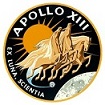
Day 6, part 5: Service Module Separation
Corrected Transcript and Commentary Copyright ©2020 by W. David Woods, Johannes Kemppanen, Alexander Turhanov and Lennox J. Waugh. All rights reserved.
Last updated 2020-04-21
137:40:49 Haise: Okay. If you're happy, can we maneuver to Service Module Sep attitude now?
137:40:57 Kerwin: That's affirmative, Aquarius. [Long pause.]
That was Fred Haise requesting that 13 maneuver to Service Module separation attitude following this - this burn which went right on the money. We're at 137 hours, 41 minutes.
137:41:19 Lovell: And I'm pitching up to the proper attitude.
137:41:23 Kerwin: Okay. We're looking at it.
137:41:26 Lovell: And it's again necessary to use the TTCA to pitch.
137:41:30 Kerwin: Okay. Affirmative.
For the Service Module separation, Apollo 13 will pitch about 90 degrees along the radial axis. That's 90 degrees off the flight path angle. We show 13 at the present time at a distance of 37,581 nautical miles away with a velocity of 10,138 feet per second. We're now at 137 hours, 42 minutes into the mission. This is Apollo Control Houston.
137:43:55 Kerwin: Aquarius, Houston.
137:43:58 Lovell: Go ahead, Houston.
137:43:59 Kerwin: Okay. Recommend you terminate P41. [Pause.]
137:47:38 Slayton: Hey, Jim, have you broken into the medical kit per my recommendation a few hours ago?
137:47:46 Lovell: Yes. Everything is taken care of Deke.
137:47:49 Slayton: Okay, fine. You might hit it again in about 2 hours.
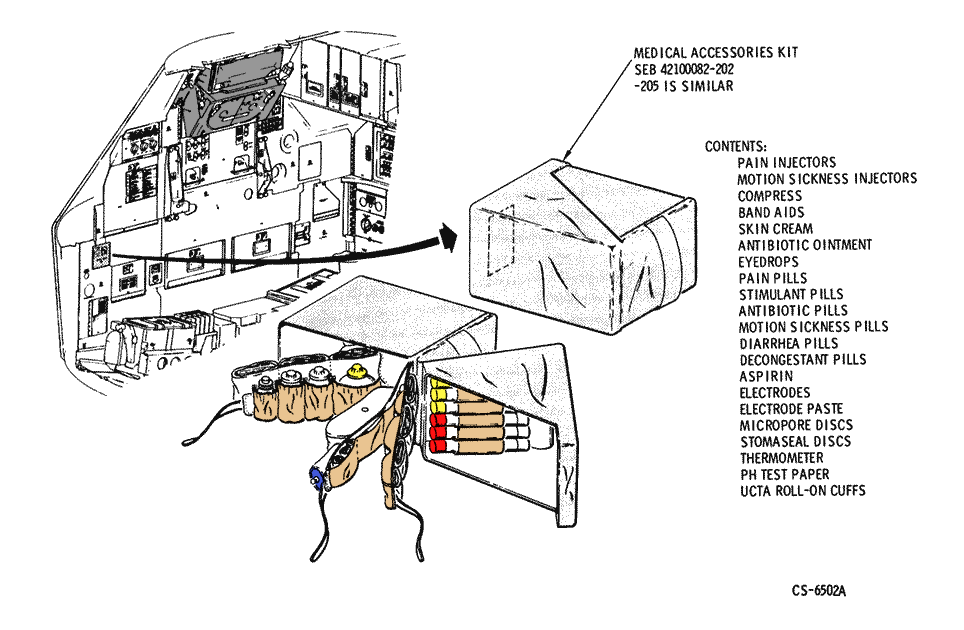
Apollo Command Module medical kit.
Apollo Control Houston, 137 hours, 48 minutes. That was Donald K. Slayton on the line talking to Jim Lovell; the recommendation he referred to was the recommendation he made earlier in the morning that the Apollo 13 crew take Dexedrine tablets. We now show Apollo 13 in an altitude of 36,969 nautical miles.
Apollo Control, Houston. The Guidance and Control Officer for the Lunar Module here in Mission Control confirms they are moving in an attitude now for separation.
137:50:37 Kerwin: Aquarius, Houston. Aft Omni.
137:50:41 Lovell: I beat you to it, Houston.
137:50:43 Kerwin: Yes. I thought you did, but I thought I'd say it anyway.
Our countdown clock shows that we are 19 minutes away now from time of separation; Service Module jettison; for this, Jack Swigert is in the Command Module; Jim Lovell and Fred Haise in the Lunar Module; Commander Lovell will fire the thruster, or fire the thrust, LM thrust to push the Service Module at one half foot per second; Swigert activates the Pyros with a switch in the Command Module. After separation, 13 will back off with the Lunar Module RCS at one half foot per second, providing the separation delta velocity of one foot per second. We are 137 hours, 52 minutes into the flight and Apollo 13 now 36,616 nautical miles away. This is Apollo Control, Houston.
137:55:52 Kerwin: Okay, Aquarius; Houston. That attitude looks pretty good. How's Jack getting along?
137:55:58 Lovell: He's getting along, all set to go. And I'm going to go into PGNS Att Hold.
137:57:06 Kerwin: Aquarius, Houston.
137:57:10 Lovell: Go ahead.
137:57:11 Kerwin: Roger. Again for fuel-consumption reasons, we'd like you to go back to the AGS mode you were in rather than PGNS Att Hold. Over.
137:57:20 Lovell: Okay. I'm in PGNS Minimum Impulse right now while we're firing. And I'll go back to the AGS mode.
137:57:31 Kerwin: Okay, Jim. PGNS Min Impulse is okay; AGS is okay too. It's your choice.
137:57:37 Lovell: Soon as we get rid of the Service Module, Joe, I think I'll be able to maneuver a lot better.
137:57:42 Kerwin: Sure thing.
137:57:48 Lovell: Okay, Jack just reported that all thrusters fired on both rings.
137:57:53 Kerwin: Real fine. Real fine. [Long pause.]
That was the test of the thrusters on the Command Module, and as you heard, they all fired - we are at 137 hours, 58 minutes into the flight; and this is Apollo Control, Houston.
137:58:32 Lovell: And SM Jett at 138:12. [Pause.]
137:58:43 Kerwin: Roger. Understand; that's SM Jett, 138:12. It's not that time critical, Jim.
137:58:52 Lovell: Can we do it at any time, Joe?
137:58:55 Kerwin: I think so, but let me check. Aquarius, Houston. That's affirmative. You can jettison the Service Module when you are ready; no big rush, but any time.
137:59:14 Lovell: Okay. Sounds good.
138:00:41 Kerwin: Aquarius, Houston.
138:00:44 Lovell: Go ahead.
138:00:45 Kerwin: Roger. We recommend that you use the AGS for the separation maneuver, because we'd like to get the proper weight in for the DAP before we use the PGNS again.
138:00:59 Lovell: Roger. We will. Stand by.
Apollo Control, Houston; 138 hours, 1 minutes into the flight. As you heard earlier, Joe Kerwin told Apollo 13 that they could separate at their convenience, that followed a time identified by Jim Lovell, which would be some 2 minutes after what we had earlier carried on the ground, we now show Apollo 13 at a distance of 35,729 nautical miles away from Earth, traveling at a speed of 10,400 feet per second. At 138 hours, 2 minutes into the flight; this is Apollo Control, Houston.
138:02:06 Lovell: SM Sep.
138:02:09 Kerwin: Copy that.
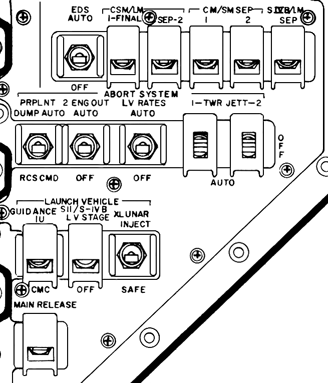
Pyrotechnic separation control switches on the bottom of Panel 2 on the MDC. Original scan via heroicrelics.org.
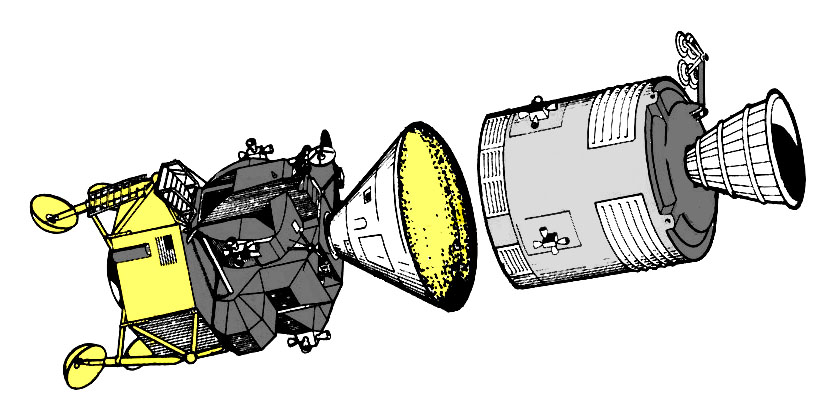
Diagram of the Service Module separation.
We copied that report from Jim Lovell, that Service Module separation at 138 hours, 2 minutes, 8 seconds. And as you heard, that was ahead of schedule. We presently show Apollo 13 at 35,611 nautical miles [65,952 km] away from Earth.

Command Module/Service Module electric interrupter.
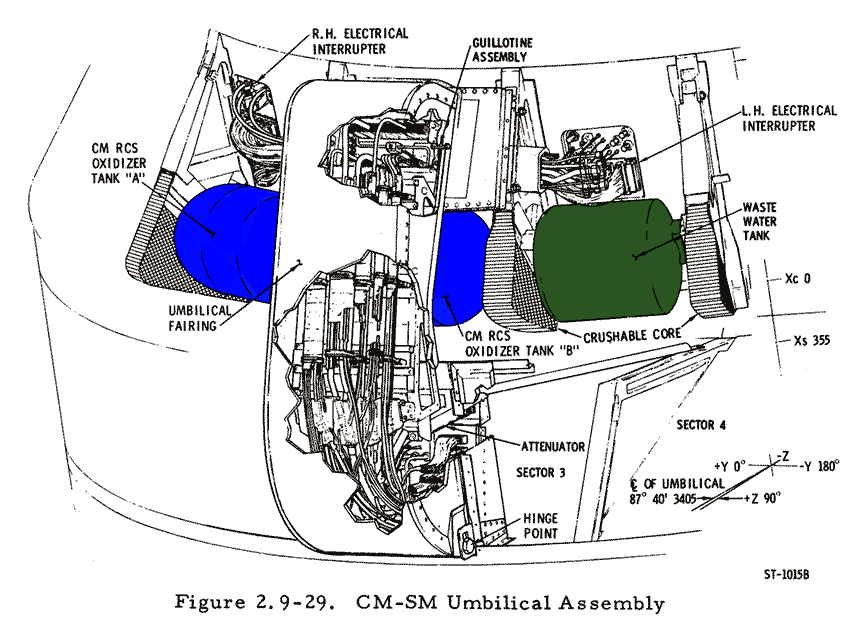
Service Module Umbilical
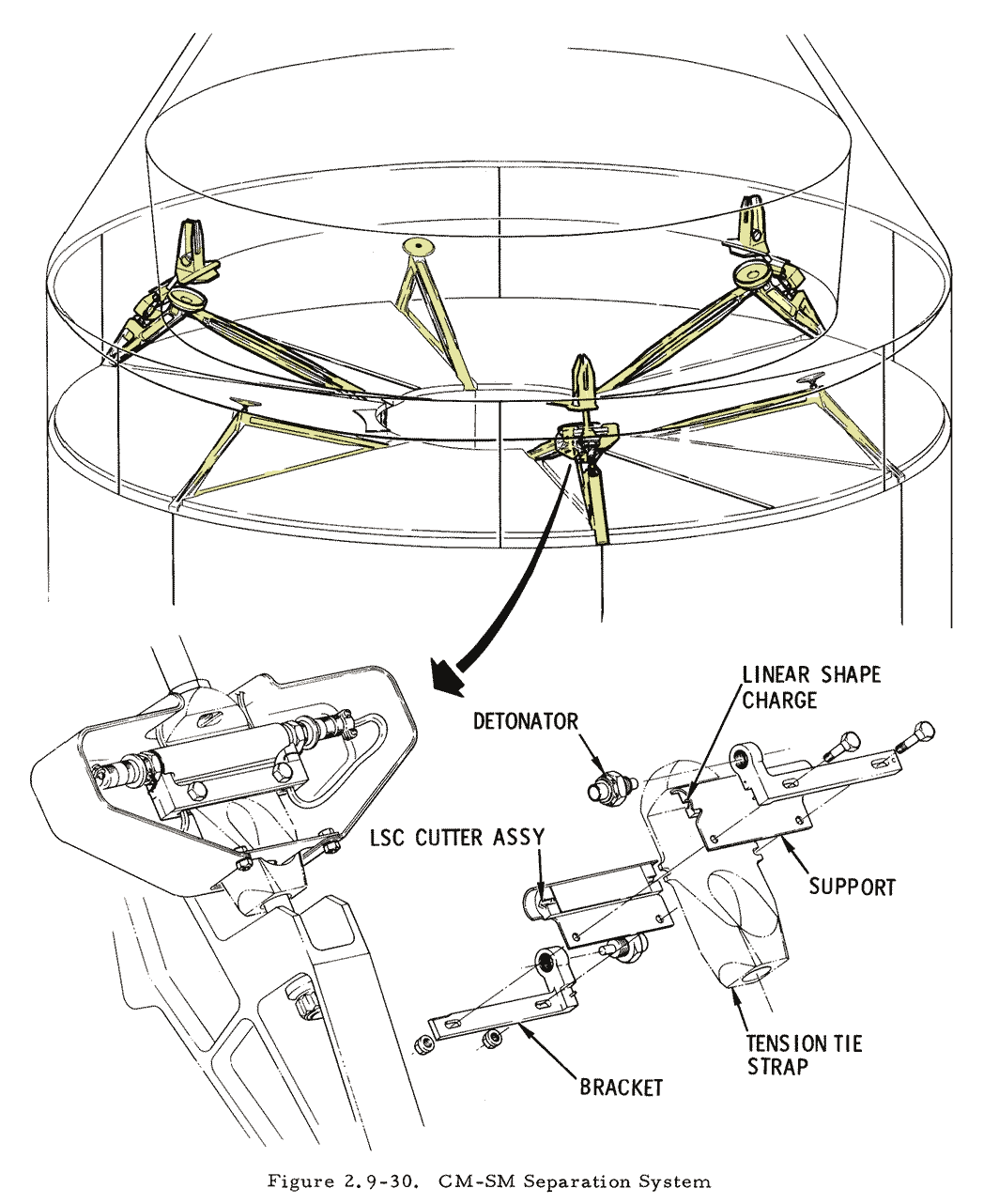
Command/Service Module tension ties.
138:03:53 Lovell: Do you see it, Jack? [Long pause.]
138:04:26 Kerwin: Okay, Aquarius; Houston. I recommend you terminate Average G. Over.
138:04:33 Lovell: Okay, I've got her, Houston.
138:04:36 Kerwin: Beautiful, beautiful. And for you information, Jim, you'll be coming up on an RCS caution light for helium. No sweat. Over.
138:04:46 Lovell: And there's one whole side of that spacecraft missing.
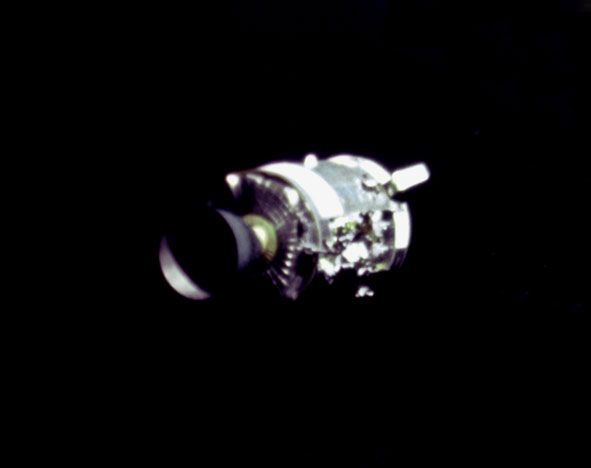
The newly separated Service Module floating away. This color image shows the missing panel and the now released SM/CM umbilical, on the top.
138:04:50 Kerwin: Is that right? [Pause.]
138:04:57 Lovell: Right by the - Look out there, will you? Right by the high gain antenna, the whole panel is blown out, almost from the base to the engine.
138:05:09 Kerwin: Copy that. [Long pause.]
138:05:22 Haise: Yes, it looks like it got to the SPS bell, too, Houston.
138:05:28 Kerwin: Think it zinged the SPS engine bell, huh?
138:05:31 Haise: That's the way it looks; unless that's just a dark brown streak. It's really a mess. [Long pause.]
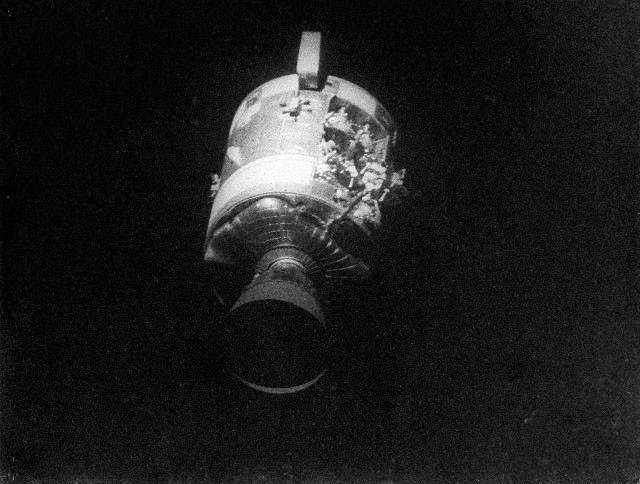
The damage inside sector 4 is evident. The hull panel is almost entirely gone, and although the fuel cells can be seen on their installed positions, the section with the cryogenics tanks and their support equipment is a jumble of jagged metal and broken insulation.
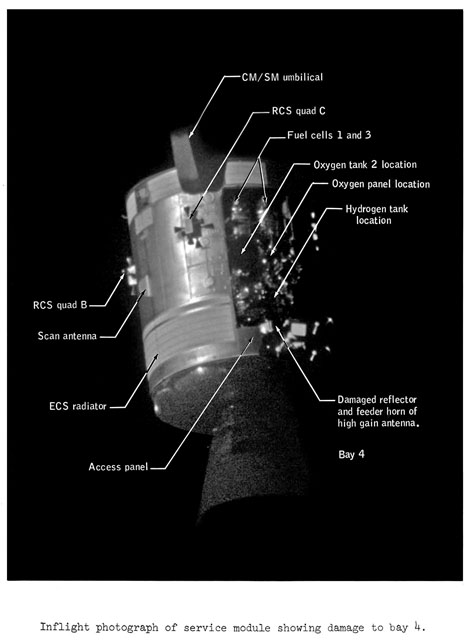
While the crew was only able to take a glimpse and describe what they saw, the photographs they took were used to analyse the total extent of the damage. The place of the O2 Tank 2 is empty. Damage is visible to the High Gain Antenna and the SPS engine nozzle as well.
You heard that report from Jim Lovell, as Aquarius is moving away from the Service Module at the present time.
138:05:51 Kerwin: Okay, Jim. We'd like you to get some pictures, but we want you to conserve RCS. Don't make unnecessary maneuvers. [Long pause.]
138:06:08 Kerwin: And, Jim; Houston. In particular, of course, we don't want any translation maneuvers.
138:06:16 Lovell: Right on that. Joe, you realize that when I went up to the SM Sep attitude, I had to use TTCA to do it.
138:06:25 Kerwin: That's affirm. We know that. That's okay. [Long pause.]
Fred Haise followed Jim's remark with the comment that it got through the Service Propulsion System bell too. That it was really a mess. We're at 138 hours, 7 minutes into the flight. Apollo 13 now 35,200 nautical miles...
138:06:50 Lovell: All right. She's drifting right down in front of our windows now, Houston.
138:08:12 Haise: Okay, Joe, I'm now looking down the SPS bell, and it looks - looks okay on the inside; maybe it is just a streak.
138:08:19 Kerwin: Okay. Copy that, Fred. Was the bell deformed on the outside or just nicked or what?
138:08:33 Lovell: I think the explosion, from what I could see, Joe, had - had stained it. I don't know whether it did any actual deformation or not.
138:08:41 Kerwin: Okay. [Long pause.]
138:09:09 Haise: Man, that's unbelievable! [Long pause.]
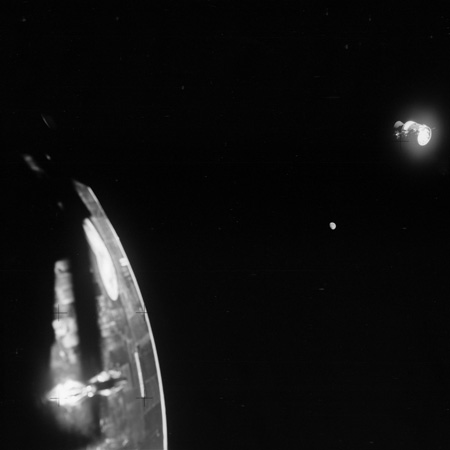
The skin of the Command Module and the Service Module shine in sunlight, betraying the fogged-up windows of the LM. The now distant Moon is also seen as a bright spot.
138:09:38 Lovell: And, Joe, looks like a lot of - a lot of debris is just hanging out the side near the S-band antenna.
138:09:47 Kerwin: Roger, Jim. [Long pause.]
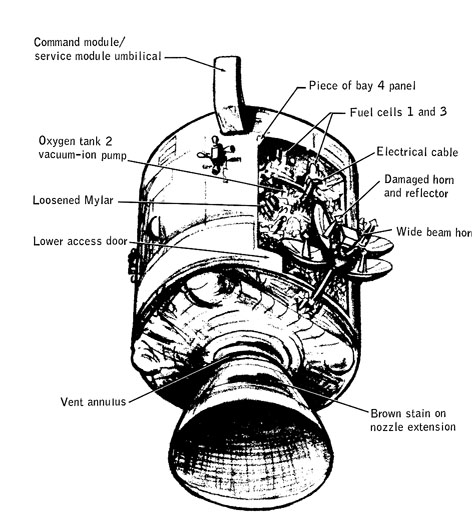
Drawing of the Service Module based on the photographs. From the Investigation Report. Electric cables and pieces of insulation spew out of the damaged Service Module. While the fuel cells can be identified, the space that should be occupied by the number 2 oxygen tank is empty. The damage to the high gain antenna is very much evident too, with one of the horns visibly twisted from the bay 4 panel hitting it.
138:10:43 Kerwin: Aquarius, Houston.
138:10:46 Lovell: Go ahead.
138:10:47 Kerwin: I know you're busy, but when Jack gets a chance, we'd like Bat C current and Main A voltage in the Command Module.



